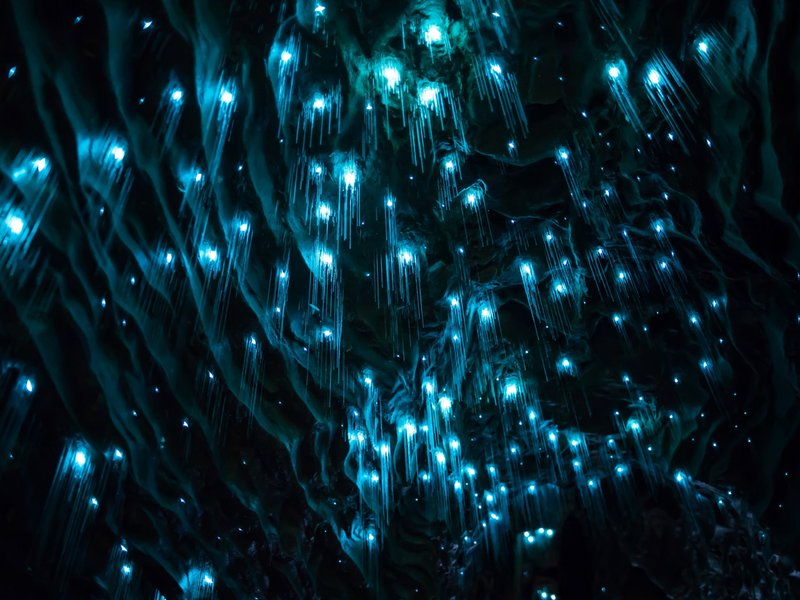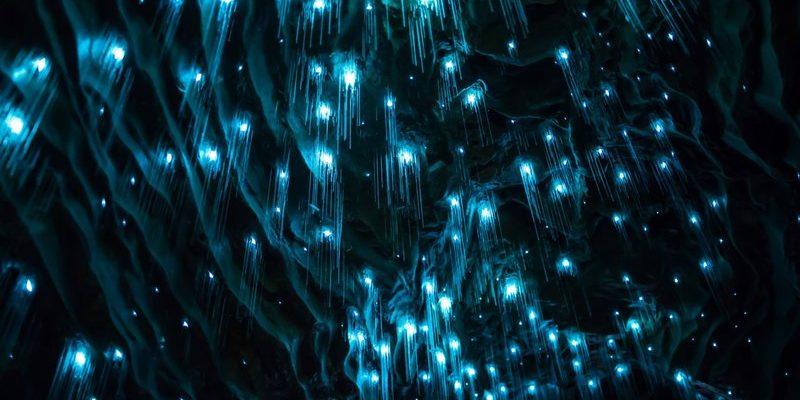
Glow worms aren’t just pretty lights; they play a crucial role in the cave environment. These bioluminescent creatures help control other insect populations while also attracting prey. But what about their cave companions? From bats to unique fungi, several species share their dark abode, each playing a part in the intricate web of cave life. Understanding these relationships can open our eyes to the importance of conservation and the complexities of nature that often go unnoticed.
What Are Glow Worms?
Glow worms are actually the larvae of certain species of beetles, specifically the *Lampyridae* family. When people think of glow worms, they often envision the beautiful glow emanating from their bodies. This light, known as bioluminescence, is created through a chemical reaction in their bodies, emitting a soft, greenish-blue light.
These little larvae are primarily found in caves or damp, dark environments where they can thrive. During their bright stage, they use their glow to attract unsuspecting insects, which they ensnare in sticky silk threads they spin around themselves. It might sound a bit like a horror movie, but it’s essential for their survival. **Without this attraction method, they’d struggle to find food**.
The glow is not just for show; it’s a survival tactic. Just like a lure for fish, glow worms entice flying insects, which they capture. It’s all part of the circle of life—where every glowing light has a purpose.
Cave Ecosystems: A Unique Habitat
Caves are unique ecosystems that host a variety of species living in close quarters. The darkness creates a habitat that is often inhospitable to many creatures, but some thrive in these conditions. You might be surprised to learn that a cave can be home to a complex web of life.
These ecosystems support not just glow worms but also other insects, bats, and even fungi. Each species plays a specific role, creating an intricate balance. For example, bats rely on caves for shelter and often feed on the very insects that glow worms attract. It’s like a natural buffet down there, where the menu is always changing.
Moreover, caves often hold large amounts of water, which can be a significant resource for both flora and fauna. The unique moisture level supports different types of algae and fungi, adding to the biodiversity of cave life. You might think of it as a hidden jungle, thriving in the dark.
Co-Occurring Cave Species
The relationship between glow worms and other cave-dwelling species is a fascinating topic. Let’s dive into some of the most common inhabitants you might find alongside glow worms.
- Bats: Bats are perhaps the most well-known cave dwellers. They use echolocation to navigate and find food in total darkness, often feeding on the very insects glow worms attract.
- Cave Crickets: These critters thrive in the dark and are often found hopping around caves. They play a role in the cave ecosystem, breaking down organic material.
- Fungi: Various fungi species grow in the damp cave environment. Some can even feed on dead organic matter, recycling nutrients back into the ecosystem.
- Snails: Unique cave-dwelling snails have adapted to their environment, often developing specialized features to survive in the dark.
Each of these species interacts with glow worms in interesting ways. For instance, bats help control the insect population that might otherwise overwhelm glow worms. It’s a reminder of how interconnected life is, even in the most unlikely settings.
The Role of Glow Worms in the Ecosystem
Glow worms are vital to the cave ecosystem. Their role extends beyond being mere decorations in the dark. They contribute to the food chain, and their bioluminescence plays a part in nutrient cycles within caves.
When glow worms catch insects, those insects become food not just for bats but also for other cave dwellers. It’s a little like being the star of an underground dinner party, where everyone benefits from your role. They also contribute to the nutrient cycle when they die, providing sustenance for fungi and bacteria, which in turn support other forms of life.
Here’s the thing: glow worms are often seen as a standalone attraction, but they are interconnected with their environment. Keeping their populations healthy is crucial for maintaining the balance in caves. If glow worms decline, the entire system could be affected, showcasing just how important they really are.
Conservation of Glow Worms and Cave Ecosystems
As we learn more about glow worms and their cave companions, it’s essential to consider their conservation. Caves are often threatened by human activities, such as tourism, mining, and pollution. These activities can damage habitats and disrupt the delicate balance of cave ecosystems.
Protecting glow worms means protecting their habitat. Educating the public about these incredible creatures and their ecosystems can help promote conservation efforts. Visiting caves responsibly, following guidelines, and ensuring no waste is left behind are crucial steps for preserving these unique environments.
Moreover, conservation efforts can extend beyond just caves. Awareness about how our actions impact the environment, including light pollution and climate change, can help protect these precious habitats. It’s about preserving the magic of caves for future generations.
So, next time you hear about glow worms, remember they’re more than just pretty lights in a dark cave. They’re part of a complex ecosystem filled with unique life forms, each with a role to play. From bats to crickets and fungi, every species contributes to the delicate balance that makes caves such enchanting places.
Understanding the relationship between glow worms and co-occurring cave species highlights the importance of protecting these environments. With a little effort and awareness, we can ensure that these magical ecosystems continue to thrive, lighting up the dark for years to come. Let’s keep exploring this hidden world and appreciate the wonders it holds!

